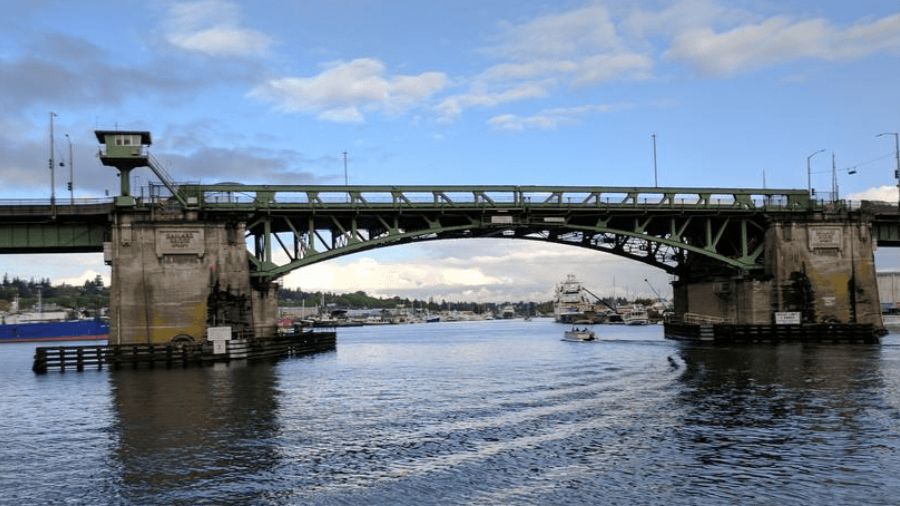With aging maritime industry jeopardizing state’s ferries, meet the next gen of diverse mariners
Apr 12, 2022, 6:17 AM | Updated: 10:03 am

Seattle Maritime Academy students working on engines (Chris Sullivan)
(Chris Sullivan)
A crew shortage has forced the Washington State Ferries to work with a reduced alternate schedule during and through the pandemic. Staff shortages across the industry have only gotten worse, even as the call for new workers has increased. So, where is the next generation of mariners?
The graying of the maritime industry has been like a wave on the horizon, slowly getting larger as it races toward the shore.
Twenty percent of the entire maritime industry is within five years of retirement, according to Dale Bateman, the associate dean of the
Compounding the problem is the lack of diversity in the industry: It’s hard to attract people when you don’t see anyone like yourself in it.
“It’s an industry where it works just fine until suddenly it doesn’t anymore,” he said. “We’re very rapidly reaching the ‘it doesn’t anymore.’ We need new blood into the industry and bringing in folks from some of those under-represented communities is a great way for us to bring in new blood, young blood to make some really positive changes.”
Washington ferry cancellations go ‘beyond COVID’: Report highlights systemic staffing issues
It’s also hard to recruit new people when they don’t even know working on boats, ferries, and ships is a career choice.
Be honest — when you think of going into the trades, you think electrician, plumber, carpenter, mechanic, and plenty of other options. The maritime industry probably isn’t in the top 10.
Hana Stevanonic is a 30-year-old oiler for WSF. She started in January after a friend told her about this career path, and graduated from the academy in 2020.
“I think there’s a gap between going out on a boat and people thinking ‘it’s a cool career but I couldn’t do that,'” she said. “There’s not really a clear path for doing it.”
She decided to take the one-year, $10,000 program at the Seattle Maritime Academy, even though she graduated from the University of Washington with bachelor’s degrees in biology and environmental studies, but careers down that path didn’t seem to lead anywhere.
“The careers are like $30-40,000 entry-level, and I don’t really see a progression in salary,” she said. “I was serving tables, and making just about the same amount of money.”
Think about that: Two degrees and waiting tables because the jobs in her field just couldn’t pay the bills.
“You get two years of accelerated learning in one year,” she said of SMA. “You get your credential. You get your QMed, and then you go out and start making money immediately. If people knew that, maybe there would be more people here.”
The QMed is the Coast Guard requirement to work in an engine room. She worked for a fishing boat in the Bering Sea during her 90-day paid internship and stayed another eight months because she enjoyed it so much.
Stevanovic made $10,000 last month working for the ferries, even as an on-call, bottom rung of the ladder, engine room oiler. Her goal is to become a Chief Engineer making well over $100,000 by the time she’s 40.
Jonathan Mosley is 39 years old, and say he might have made a different choice two decades ago when he was coming out of high school if he knew this industry was a thing. He went into the Air Force instead, retiring last year.
“If I had the opportunity to go back and tell myself, ‘should I go into the military or should I do something in the realm of trades versus college,’ I would choose this over college. I’m not saying the college is bad, but I would say do the trades first,” he said.
Mosley is in the middle of the one-year program at the academy, with a fully paid 90-day at sea internship coming up this summer.
“You’re set up with a career, and you’re not saddled with student debt,” he said. “There’s no downside.”
He believes the push to college by parents over the last 50 years has really led to the staffing shortages we see across all industries.
“Our culture drives ‘go to college’ at all costs,” Mosley said. “We almost look down on the blue-collar industries, even though those are paying as much if not more than other jobs that require a master’s degree.”
The Seattle Maritime Academy is having an open house Tuesday, where you can learn all about the maritime industry. There’s still room for the next class, which starts in September.
Bateman’s pitch: “You can get a really great job without having a four-year degree. After a one-year program here, you could be making $70-80,000 a year working for Washington State Ferries as an engineer. That’s not a bad gig.”
New hires do have to work through the on-call system with the ferries, which has been a deterrent to some, but with the current staffing levels, the wait for a full-time job is not as long as it used to be. Stevanovic started the year number 36 on the on-call list. She’s now number-19, and there are full-time jobs she can apply for.
Check out more of Chris’ Chokepoints.












